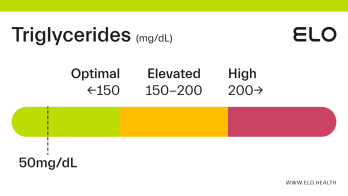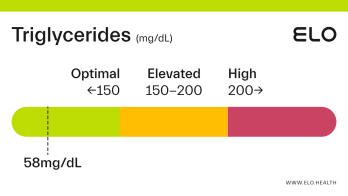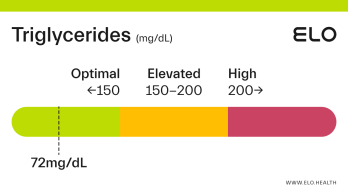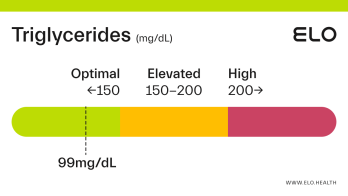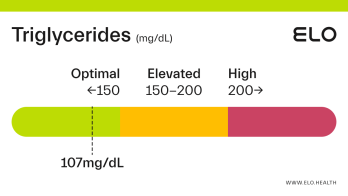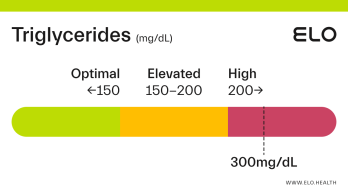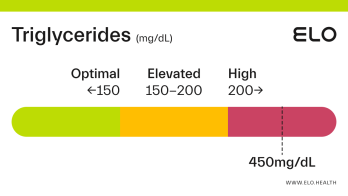Triglycerides: 200 mg/dL
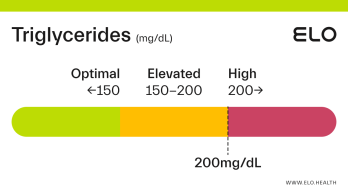
What does a triglyceride test result of 200 mean? Are there any symptoms associated with this triglyceride level?
A triglyceride level of 200 mg/dL is considered high. High triglyceride levels put you at greater risk for heart disease, and can also be a sign of type 2 diabetes, prediabetes, metabolic syndrome, and hypothyroidism [2].
High triglycerides typically don’t cause any symptoms, however, extremely high levels (>1000 mg/dL) can cause pancreatitis, acute inflammation of the pancreas. Symptoms of pancreatitis include severe abdominal pain and tenderness, vomiting, diarrhea, high fever, jaundice, and a high heart rate.
Lowering high triglyceride levels will reduce your risk of developing heart disease and other health issues. If you already have heart disease, lowering your triglycerides can lessen your odds of serious complications, like a heart attack or stroke.
Factors that could contribute to a triglyceride level of 200:
A variety of factors can affect triglyceride levels including your diet, weight, physical activity level, smoking, and drinking. Some medications and certain diseases also impact triglyceride levels.
Diet: Diets that are high in fat, added sugar, and refined carbohydrates can increase triglyceride levels.
Weight. Having excess fat, particularly around the abdomen, can also increase triglycerides.
Physical Activity. Being active can help lower triglyceride levels.
Medications: Certain medicines can raise your triglyceride level including corticosteroids, beta-blockers, thiazide diuretics, antivirals, and estrogen.
Some medical conditions: Diseases involving the thyroid, liver, or kidney, as well as poorly controlled type 2 diabetes, can change triglyceride levels.
Smoking: Smoking is associated with high triglycerides.
Excessive alcohol consumption: Heavy drinking can also contribute to high triglyceride levels.
What to do if your triglyceride level is 200?
Making changes to your diet and adopting healthier habits can help lower your triglyceride level. The lower, the better.
To lower your triglycerides:
Exercise for 30-60 minutes 5x/week.
Lose weight by reducing your calorie intake.
Avoid refined carbs and limit added sugars to <25g/day.
Limit alcohol consumption to <1-2 drinks per day.
Eat healthier fats like those found in nuts, seeds, avocados, olive oil, and salmon.
Avoid trans fats and limit saturated fat to <10% of total calories.
Quit smoking.
Medications and supplements used to improve triglyceride results
If diet and lifestyle changes do not lower triglyceride levels enough on their own, some medications and supplements may help.
Medications
Prescription niacin: Niacin is a B vitamin that, when taken at prescription doses, can lower triglyceride levels and improve HDL (good) cholesterol levels. It works by blocking the enzyme responsible for making cholesterol in the liver.
Fibrates: Fibrates can help lower high triglyceride levels and may also help raise HDL (good) cholesterol. They work by reducing the liver's production of VLDL (the triglyceride-carrying particle in the blood) and by speeding up the removal of triglycerides from the blood.
Statins: Statins (including atorvastatin, simvastatin, and rosuvastatin) may be prescribed if your LDL and total cholesterol levels are also elevated. Statins reduce cholesterol production in your liver and lower blood cholesterol levels. Because they typically need to be taken for life, statins are only prescribed if diet and lifestyle changes aren’t enough [3].
Supplements
Fish oil: The omega-3 fatty acids in fish oil can help lower your triglycerides. Prescription fish oil contains more active fatty acids than many nonprescription supplements but can interfere with blood clotting, so check with a doctor before taking a high-dose supplement.
References
Cholesterol Levels: What You Need to Know. (n.d.). U.S. National Library of Medicine | NIH. Retrieved September 9, 2021, from
https://medlineplus.gov/cholesterollevelswhatyouneedtoknow.html
Triglycerides: Why do they matter? (2020, September 29). Mayo Clinic.
https://www.mayoclinic.org/diseases-conditions/high-blood-cholesterol/in-depth/triglycerides/art-20048186
High cholesterol. (n.d.). NHS Inform. Retrieved September 9, 2021, from
https://www.nhsinform.scot/illnesses-and-conditions/blood-and-lymph/high-cholesterol
Cholesterol: Types, Tests, Treatments, Prevention. (2020, July 31). Cleveland Clinic.
https://my.clevelandclinic.org/health/articles/11920-cholesterol-numbers-what-do-they-mean
Blood Cholesterol | NHLBI, NIH. (2021, January 4). National Institutes of Health.
https://www.nhlbi.nih.gov/health-topics/blood-cholesterol
LDL: The “Bad” Cholesterol. (n.d.). National Institutes of Health. Retrieved September 22, 2021, from
https://medlineplus.gov/ldlthebadcholesterol.html

